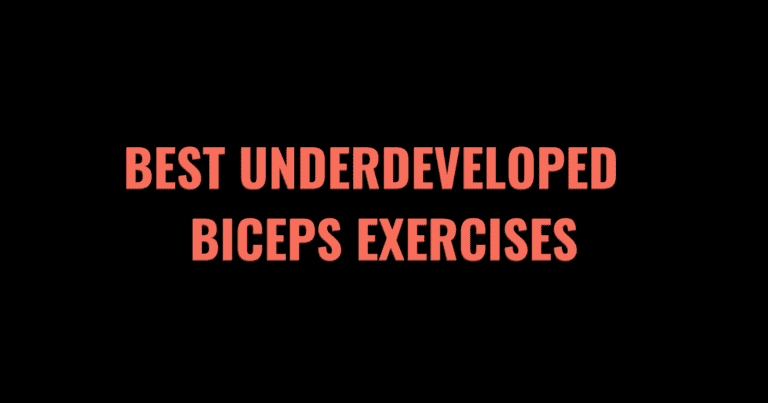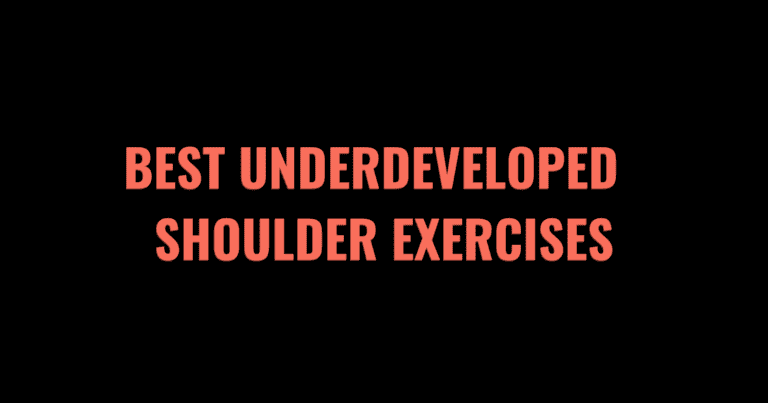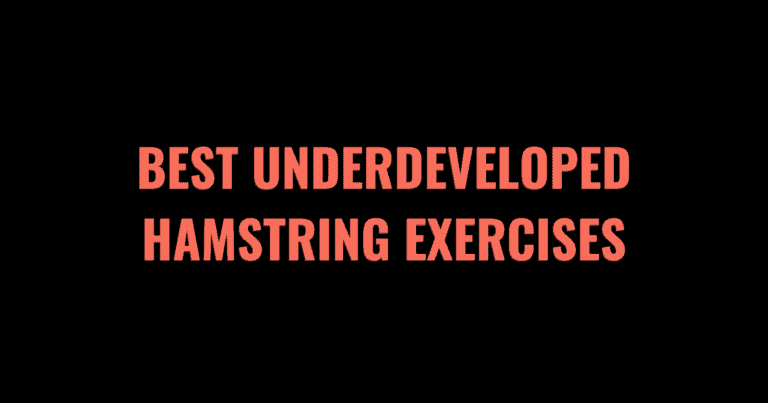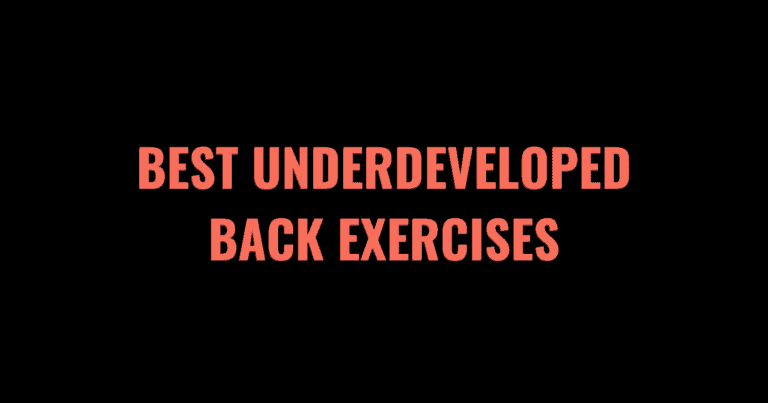Underdeveloped triceps occur when the muscles on the backs of your arms lag in size or strength compared with other muscles like the biceps or delts. You can grow underdeveloped triceps by increasing weekly volume, training the triceps with more intensity, and prioritizing tricep isolation exercises that emphasize the long tricep head.
The triceps are the largest muscle in your upper arms, but some lifters struggle to increase their size and strength. If you want to build larger upper arms, targeting the triceps is critical.
We’ll review the best ways to grow triceps to increase your upper body musculature. We’ll also share some of the best triceps exercises, ideal rep ranges, and tips to help you build stronger and bigger triceps.
Table of Contents
- 1 The 5 Best Ways to Grow Bigger Triceps
- 2 Best Exercises for Bigger Triceps
- 3 What are Underdeveloped Triceps?
- 4 Triceps Anatomy
- 5 Triceps FAQs
- 6 Grow Underdeveloped Muscle Groups
- 6.1 The 8 Best Ways to Grow a Bigger Lower Chest
- 6.2 The 8 Best Ways to Build an Underdeveloped Core
- 6.3 The 8 Best Ways to Grow Bigger Upper Abs
- 6.4 The 7 Best Ways to Grow Underdeveloped Obliques
- 6.5 The 8 Best Ways to Grow Bigger Traps
- 6.6 The 8 Best Ways To Grow a Bigger Upper Chest
- 6.7 The 8 Best Ways to Grow Bigger Biceps
- 6.8 The 8 Best Ways to Grow Bigger Shoulders
- 6.9 The 8 Best Ways to Grow Bigger Hamstrings
- 6.10 The 8 Best Ways to Grow a Bigger Back
- 6.11 The 7 Best Ways to Grow Bigger Rear Delts
- 6.12 The 8 Best Ways to Grow Bigger Front Delts
- 6.13 The 8 Best Ways to Strengthen Abs
The 5 Best Ways to Grow Bigger Triceps
- Increase your tricep training volume
- Increase the intensity of your tricep exercises sets
- Prioritize tricep isolation exercises
- Max out with bodyweight tricep exercises
- Focus on the long head of your triceps
1. Increase Your Tricep Training Volume
Since they are a relatively small muscle group that can recover quickly, the triceps can handle high volume. The triceps training volume landmarks guide from Renaissance Periodization suggests that a minimum of four sets per week are needed to maintain your triceps’ current size and strength. This is in addition to any chest pressing work and refers to tricep-specific training.
You need even more volume if you are trying to grow underdeveloped triceps. Most intermediate lifters should do at least six sets per week, ideally split into two weekly sessions.
More advanced lifters can benefit from as many as 16 sets per week divided into two sessions or 20 sets split into three weekly sessions.
If you are highly advanced and recovering well, you could perform up to 30 sets per week of triceps exercises, divided into 5 or 6 sessions. The division of your sets will depend on your exercise selection, as compound chest pressing exercises take longer to recover from than tricep isolation exercises.
While you can benefit from high tricep training volume, avoid the trap of thinking more is always better. There is a point of diminishing returns regarding training volume, and doing too many extra junk reps and sets could hinder your gains or even set you back in your tricep growth goals. Gradually increase your weekly volume, prioritize perfect form, and allow for recovery to effectively develop your triceps muscles.
2. Increase the intensity of your tricep exercises sets
Adding volume is just one way to progressively overload your target muscle groups. You can also break through plateaus and grow stubborn or weak triceps by increasing the intensity of your workouts.
Some research suggests that higher intensity, or training your sets closer to failure, more efficiently increases hypertrophy than adding more volume. You can increase the intensity of your tricep training by lifting heavier weights, increasing time under tension, or perfecting your form.
Lifters are notoriously poor at accurately estimating their reps in reserve (RIR) or rate of perceived exertion (RPE), meaning they probably have more reps in the tank than they think. If you have been struggling to grow your triceps, even though you feel like you are training as hard as you can, you could benefit from a coach or a spotter to push you closer to muscular failure (MF).
You can also incorporate super sets or tri sets, drop sets, forced reps with a partner, and static holds at the point of peak contraction to get more out of your working sets.
3. Prioritize tricep isolation exercises
The prioritization principle is essential when developing lagging muscle groups. It’s tempting to add tricep exercises to the end of a shoulder or chest-focused workout, but this can result in training the triceps with less energy and mental focus.
Placing tricep-focused movements earlier in your session allows you to attack them more intensely. Remember that the more specific your goal, the more specific your training should be.
4. Max out with bodyweight tricep exercises
To add more volume without taxing your joints or nervous system with heavy loads, add extra sets of bodyweight exercises like bench dips and diamond push-ups to promote new triceps muscle growth.
Since the triceps can handle relatively high-volume training, you could do weighted tricep exercises two or three times a week and supplement the core sessions with one or two sets of diamond push-ups or bench dips to failure one or two times a week.
If you’re not able to comfortably perform tricep dips, don’t worry. Check out our list of effective tricep dip alternatives.
5. Focus on the long tricep head of your triceps
The long head of your triceps comprises ⅔ of the total tricep muscle belly but is often neglected when compared to the triceps muscle’s lateral head and medial head. Overhead tricep exercises, tricep exercises where your elbows travel behind your torso, and isolation exercises with cables where shoulder elevation is low target the long tricep.
You can tweak your regular pressing exercises to focus on the long head triceps, for example, performing a close grip bench press on a slight incline to stretch the long head more. Then add a second long triceps exercise, such as a cable overhead tricep extension, to challenge the muscle fibers in a new way.
Best Exercises for Bigger Triceps
- Close Grip Incline Bench Presses
- Overhead Cable Triceps Extension
- Cable Triceps Pushdowns
- Overhead Barbell Triceps Extension
- Dips
- Single Arm Cable Pushdowns
- Rope Overhead Triceps Extension
- Rope Triceps Pushdown
- Bent Over Dumbbell Kick Backs
- Lying Triceps Extensions
To build thick, powerful upper arms, you must focus on each tricep head. The long head is the largest of the three tricep muscle heads, so prioritizing some of the best long head triceps exercises is an excellent place to start. To ensure your triceps are well-rounded and balanced, regularly include effective medial head tricep exercises and lateral tricep head exercises.
What are Underdeveloped Triceps?
Underdeveloped triceps occur when your triceps lag in strength or size compared with your other muscles. To rectify undeveloped triceps, experiment with exercise selection, train with more intensity, move through a full range of motion, and prioritize exercises that work the long head of your triceps.
Most importantly, ensure you are doing enough weekly volume per week. The Rennaisance Periodization hypertrophy guide for triceps recommends at least six sets per week to see strength and mass gains for intermediate-advanced lifters. This volume does not include indirect tricep work through chest pressing exercises. If you do not see improvements with this much volume, you may benefit from doing as many as 30 sets split into 4-6 weekly sessions.
You should include a range of compound exercises and tricep isolation work to recover and target the triceps differently. Here’s an example of how to structure your weekly training plan to grow underdeveloped triceps.
- Day 1: Close Grip Incline Bench Press: 4 sets, 5-10 reps, Single Arm Cable Triceps Pushdowns: 2 sets per arm, 10-20 reps
- Day 2: Overhead Cable Triceps Extensions: 3 sets, 10 – 20 reps, Bench Dips: 3 sets, 10 – 20 reps
- Day 3: Diamond Push-Ups: 3 sets, 15-25 reps, Rope Triceps Pushdown: 2 sets, 15-20 reps
- Optional: 1-2 sets of max push-ups or dips between the above sessions
Triceps Anatomy
The long head of the tricep makes up around ⅔ of the total tricep muscle mass. Focusing on training the long head of the tricep targets stubborn, lagging tricep growth. Of course, you can’t neglect the medial and lateral tricep heads, but extra high-quality volume for your long tricep head can go a long way.
Many popular pressing exercises emphasize the lateral and medial tricep head. These two heads are most involved in elbow extension under a heavy load in movements like the bench press. Exercises that stretch the long tricep head and involve overhead pressing or forcing the elbow behind the body are great for training the long tricep. Check out this video from Athlean-X explaining how to target the long tricep head to boost hypertrophy.
The image depicts the long head of the tricep (highlighted in green) from a posterior view. Source: kenhub
Triceps FAQs
How often should you train your triceps?
You should train your triceps with at least six to sixteen working sets per week spread out across one to three sessions to make further hypertrophy or strength gains. An advanced lifter may need as many as 30 sets per week, combining heavier compound lifts and tricep isolation exercises. Tricep training volume is additional to chest-dominant pressing exercises like bench presses.
At what intensity should the triceps be trained?
Your triceps respond best to lifting weights between 30% and 85% of your one-rep max. If taken to failure, choose a weight you can lift for 5 – 30 reps in your first set.
Aim to do around 50% of your total weekly tricep volume within the moderate-intensity range at a weight that you safely lift for about 10-20 reps. The other 50% can be split up between heavier (weights you can lift for about 5-10 reps) and lighter (between 20 and 30 reps). Varying your intensities will help break through plateaus and strengthen weak triceps.
What rep range should be used for training the triceps?
Your sets should vary between 5 and 30 reps per set. For heavier compound exercises like close grip incline bench presses, use lower rep ranges of 5 – 15.
Around 10-20 reps are optimal for bench dips and diamond push-ups. Isolation exercises like triceps pushdowns respond best to slightly lower weights and higher rep ranges of 20-30 reps.
What types of exercises train the triceps?
Exercises emphasizing the long tricep head, like the close grip bench press, help build noticeably bigger triceps. EMG studies have found diamond or triangle pushups to be among the most effective exercises for isolating the long tricep head. They are also convenient and accessible as you can perform them anywhere without equipment. Overhead tricep extensions are great for training triceps from a fully stretched position. Bent-over kickbacks force the elbows behind the torso, another essential function of the long tricep head. Triceps pushdowns are also great because they involve low shoulder elevation, eliminating assistance from the delts and forcing the long tricep head to work harder.
Grow Underdeveloped Muscle Groups
If you enjoyed this post, check out our other guides on how to grow lagging muscle groups.












